APPLYING TECHNIQUES FOR COMBAT IN STRIKING HANDS
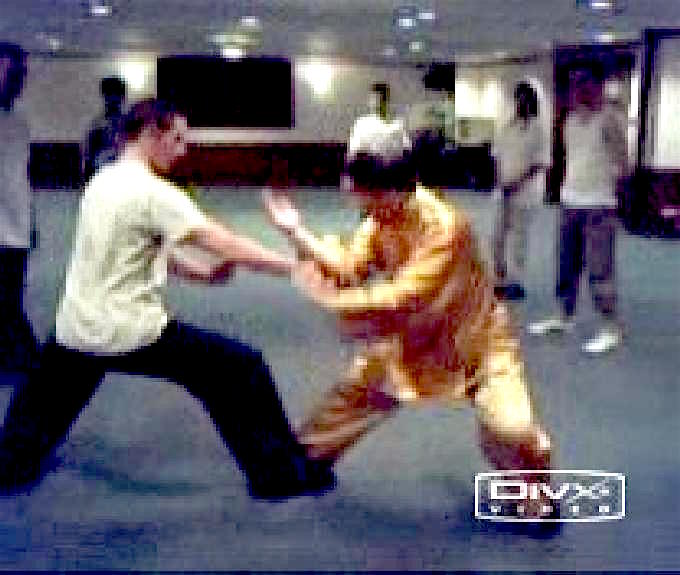
The video clips in this series serve four main functions:
- To provide resources for those who have taken the Intensive Taijiquan Course to review what they have learnt.
- To provide material for those who wish to prepare for attending an Intensive Taijiquan Course in future.
- To provide some guidance for those who may wish to benefit from our teaching.
- To provide some reference for those who have read about Taijiquan principles but have no idea of their practical manifestations.
Da Shou or Striking Hands
Although some Taijiquan practitioners may not know or accept this fact, one cannot be combat efficient by merely practicing Taijiquan forms. Hence, if we wish to practice Taijiquan as a martial art, we have to progress to Tui Shou or Pushing Hands.
But merely practicing Pushing Hands itself would be insufficient to be combat efficient — a fact some Taijiquan instructors or even masters may not realize! Pushing Hands is an ingenious way to develop combat skills, such as good timing, good spacing, flowing with the opponent, using the opponent's momentum and generating energy flow. Having developed these skills, we apply them to techniques for combat. This is trained in another aspect of Taijiquan called Da Shou, which literally means Striking Hands.
In “Striking Hands” we do not just train striking hands or techniques. We also train the other categories of combat, i.e. kicking, felling and gripping. Chinese is a concise language; “striking” in Striking Hands does not refer just to striking, but to all the four categories, just as in Chinese medicine when one says that the external causes of illness are “heat and cold”, “heat and cold” refers not just to the two external causes but all the six external causes of “heat, cold, dampness, dryness, wind and fire”.
The video clips in this series show course participants at the Intensive Taijiquan Course of January 2006 undergoing systematic training in striking and kicking techniques. Felling and gripping techniques are shown in another series on Combat Sequences which is a progression from Striking Hands.
 White Snake Shoots Venom
White Snake Shoots Venom
In Pushing Hands, you push your training partner away. Here in Striking Hand you strike him. As your partner withdraws while in the circulating hand movement, attack his throat with a palm strike, using the pattern "White Snake Shoots Venom". It is important to cover his hand with your other hand to prevent him from counter-attacking you. Your partner yields, deflects and counter-strikes in one smooth movement.
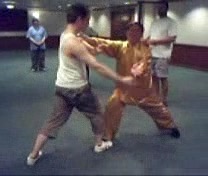 Opening an Opponent for a Palm Thrust
Opening an Opponent for a Palm Thrust
As an opponent attacks you with a palm thrust, deflects his attack by opening it and counter-attack with a palm thrust too. You may also apply this technique from the circulating movement position. Remember to cover your opponent to prevent him from counter-striking you.
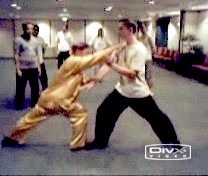 Closing an Opponent for a Palm Thrust
Closing an Opponent for a Palm Thrust
In the previous video clip you openned your opponent. Now you close him, and instantaneously strike him with “White Snake Shoots Venom”. Both the opening and the closing techniques come from “Cloud Hands”. It is important to cover your opponent for safety first.
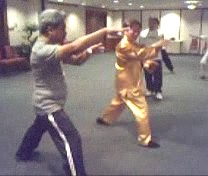 Fun and Laughter in Shaolin Wahnam Training
Fun and Laughter in Shaolin Wahnam Training
Fun and laughter is a common feature in Shaolin Wahnam training. Even matter-of-fact answers to legitimate question brings a peal of laughter from course participants. It shows how relaxed and pleasant they are even while undergoing martial art training.
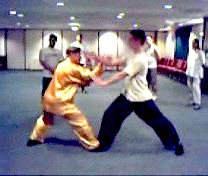 The Significance of Body-Movement
The Significance of Body-Movement
This video clip shows an example of the significance of body-movement. If both your hands are “closed” and you have been pressed back into an awkward position, an effective way to counter this is to use body-movement. Body-movement harmonizes with hand-movement and footwork, constituting the three external harmonies. The movement must be elegant, the internal energy flowing and the mind focused and relaxed, constituting the three internal harmonies.
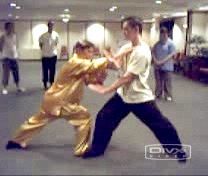 Finer Points in Taijiquan Combat
Finer Points in Taijiquan Combat
Taijiquan is a highly sophisticated martial art where a skillful exponent may clinch victory in combat using subtle movements that his opponent may not even notice. Some of these points are visible, like securing a technical advantage over an opponent while in contact, or “leaking” out from a seemingly controlled position to strike an opponent. Some are invisible, like sensing an opponent's movements and intentions, even with the eyes close.
 Low Stance Vertical Punch
Low Stance Vertical Punch
After practicing top and middle strikes, we progress to low strikes. Notice that an effective use of body-work, without moving the legs, enables you to close your opponent to strike him, or to get out of this situation if he closes your hands. Brush away a low strike at the attack's elbow instead of at his arm as this gives you better control.
 Rotation of the Waist
Rotation of the Waist
It has often been mentioned in Taijiquan classics that rotation of the waist is very important. When an opponent has pressed close to you with superior strength and has gained a technical advantage, by rotating your waist you can use minimal force to overcome his maximum strength and turn the table round against him.
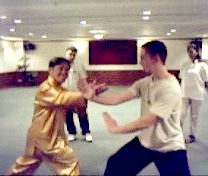 Hard against Soft, Soft against Hard
Hard against Soft, Soft against Hard
Taijiquan is not just soft, it can be hard too. If an art is only hard or only soft, it is not a great art. A great art has harmony of hard and soft. If an opponent is weaker than you, you may use “hard against soft”. On the other hand, if your opponent is stronger than you, you can use “soft against hard”. This video clip shows how these principles are applied in combat.
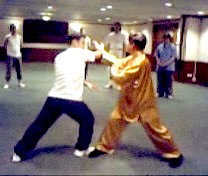 Counters against Side Attacks
Counters against Side Attacks
A complete art takes care of all forms of attacks. Having handled strikes from top, middle and bottom levels, we now handle strikes from the sides, like using “Immortal Waves Sleeves” to counter “horn punches”, or hook punches, from the sides. It is important that your counter go along with the momentum of the attack, not against it.
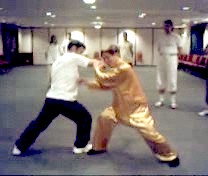 Brush Top Strike Bottom
Brush Top Strike Bottom
Another effective counter against side attacks at the top is to brush them away according to their momentum, not against it. Then strike the opponent below at his ribs, remembering to “tame” his hand so that he cannot counter-strike. This is the tactic of “Sound East Strike West”, where the brushing hand on top also acts as a distracting move besides deflecting the opponent's attack.
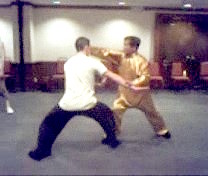 Moving to a Side to Attack
Moving to a Side to Attack
An effective way to defeat an opponent is to move to his side to strike him. If you move agilely, you can often catch him by surprise. An important skill to achieve this is good footwork. Reversely, good footwork is needed to counter such an attack, with an appropriate movement of the waist. An unskilled person may try to counter using only hand movement, which will result in his being in an awkward position.
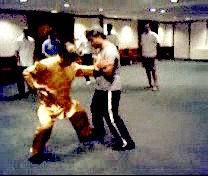 Closing an Opponent to Strike him
Closing an Opponent to Strike him
Another effective way to defeat an opponent is to close his hands and strike him simultaneously, apparently giving him no chance to defend himself. It is important that you close his hands firmly, otherwise he will strike you as you move in.
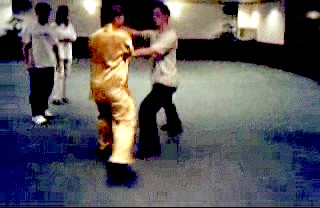 Taking a Step Back
Taking a Step Back
A simple way to counter the seemingly helpless situation when your opponent strikes you after having closed both your hands is to take a step back. As in life too, taking a step back often helps you to overcome a difficult situation.
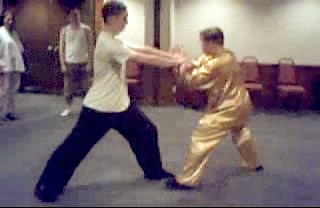 Releasing a Double Hold
Releasing a Double Hold
What would you do if your opponent grips your both hands. He may then tame your both hands with his one hand and strike you with the other. Just move a step back and simultaneously perform “Immortal Waves Sleeves”. The crucial point is the rotation of your waist rather than the turning of your hands. This will release his double hold.
LINKS
Courses and Classes
